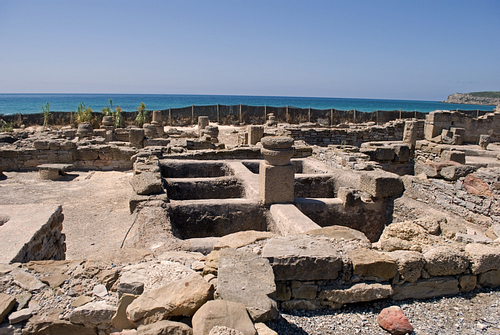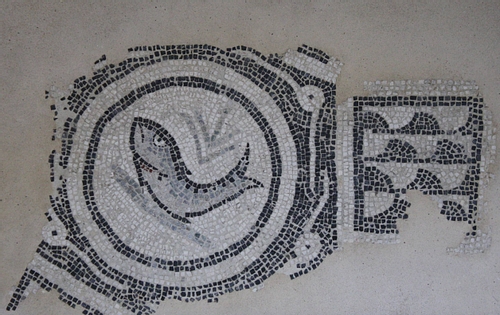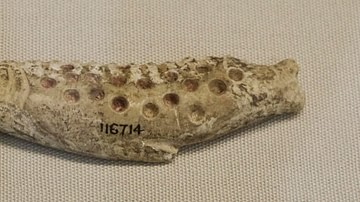The production and trade of fish sauce in the ancient world was a significant and widespread industry, stretching from Britain to the Black Sea. Roman fish sauce, known as garum, was one of the most popular and commonly used ingredients in the Roman pantry. Some historians have even argued that fish sauce, common throughout Southeast Asia today, was introduced to the continental subregion via the Silk Road.
The origins of fish sauce
Not much is known about the earliest fish sauces in Europe. The first recorded fish sauce was produced by the ancient Greeks along the coastline of the Black Sea. The abundant fishery resources of the region may have been a significant factor in Greek colonisation of the area, even as early as the 7th century BCE. Called gàros, it was made by fermenting small fish with salt which produced an amber-coloured liquid.
The Carthaginians were also early makers and traders of fish sauce, producing it along the coast of the Lake of Tunis, in modern day Tunisia. A Punic shipwreck from 5th century BCE, found off the coast of Ibiza, may have been carrying a cargo of fish sauce stored in amphorae made in Gades (modern day Spain) and Tingi (modern-day Morocco). There are many early Graeco-Roman literary references to fish sauce, from writers such as Aristophanes, Sophocles and Aeschylus. The numerous casual mentions suggest it was a commonplace ingredient in the ancient Mediterranean.
Fish sauce in ancient Rome
The Roman version of fish sauce was called garum. Many believe it originated from the Greek gàros as contemporary accounts suggest they had many similarities, notably their pungent smell. But they may have been composed of different kinds of fish and manufactured in distinct ways.
The Romans had a number of different varieties, including garum, liquamen, muria, allec and haimation. It can be hard to differentiate between the different kinds as the names were used interchangeably. Liquamen, for example, became a catch-all term for any fish sauce, though was also used as a specific term for a fish sauce made from the whole fish.
Below are definitions for the main Roman fish sauces:
- Garum - The term is often used to describe all Roman fish sauces. It may come from the Greek, gàros. Garum began as an elite food made from fish blood and could be extremely expensive. Pliny said that garum was 'blended to the colour of old honey wine' (Walker, 300).
- Liquamen - Another general term for fish sauce. Translating as 'liquid mixture', Pliny described it as the sediment of garum. It is believed to have had a lower status than garum and might have been used to extend salt supplies. The fish sauce industry was called liquaminarium and a dealer in fish sauce a liquaminarius. Liquamen was made primarily with sardines, herring, shad and eel.
- Muria - Muria was the brine filtered out after salting the fish and was usually made from tunny.
- Allec - More of a paste than sauce allec was made from leftover sediment. It contained bones and other parts of the fish that did not rot.
- Haimation - A type of garum, this was the highest quality fish sauce and therefore mainly for wealthier citizens. Haimation, or 'blood sauce', was often made from the blood and guts of tunny.
Broadly speaking, Roman fish sauces were made by mixing fish blood, guts and heads with large quantities of sea salt. The mixture was then left to ferment for varying amounts of time. According to Pliny, garum could be made with a variety of fish or shellfish, including maena, murena, tunny, mullet, oysters, and sea urchins, although mackerel was the most popular.
Popularity
Garum was popular with every level of Roman society for a number of reasons. It was an important way of preserving fish, which spoiled easily once dead. By adding salt to fish and leaving it to ferment, the growth of mould was prevented, extending the shelf life considerably. It also provided a valuable source of protein and nutrients, especially to the poor. More importantly, however, was a love of the salty, umami taste. According to Pliny, garum was an "exquisite liquid" which was "so pleasant that it can be drunk" (Walker, 300). Not everybody loved fish sauce, however. The statesman Seneca described it as "poisonous fish" which "burns up with stomach with its putrefaction" (Rimas, 51).
Uses
Relatively little is known about how garum was used in the Roman world until the 1st century CE, through the works of Marcus Gavius Apicius. Apicius, the renowned epicure, records nearly 350 recipes that use fish sauce. It was added as an ingredient in almost every recipe, including many sweet dishes. It may have also been used as a table condiment, though there is little evidence to support this.
Garum was mixed with other liquids to create new sauces, such as oenogarum (fish sauce with wine) and oxygarum (fish sauce with vinegar). The most famous sausage in the ancient world, lucanica, was smoked, spiced and given a salty flavour with the addition of liquamen. Galen, the famed 1st-2nd century CE Roman physician, even prescribed a bowl of lentils and garum for those suffering from diarrhoea.
Production
While the garum industry was not as large as that of olive oil or wine, it was still significant and widespread. Factories dedicated to the production existed across the empire, mainly found in Spain, Portugal, southern France and North Africa. To date, the largest factory uncovered in the western Mediterranean, located at Lixus (in modern-day Morocco). The site included ten factories with a salting capacity of over 1,000,000 litres. By comparison, the largest olive oil factory discovered could only produce one-tenth of this amount.
The production of fish sauce could also take place more widely than those of other foods, such as olive oil and wine, which could not be grown in certain parts of the empire. Fish, on the other hand, could be processed near any body of water that had access to a salt supply. While fish sauce was imported to Roman Britain mainly from the Iberian peninsula, archaeological sites near London, Lincoln and York have been identified as possible garum factories. Not always popular, at certain times, when the smell from production became too overwhelming, local governors had to temporarily halt production.
Due to varying types of fish and processes used, each location produced a sauce with a distinct taste, colour and consistency. By the time of Augustus (27 BCE – 14 CE), a type of fish sauce made in Cartagena and Cadiz, Spain, called garum sociorum, was considered the highest quality. Garum sociorum could be sold for 1,000 sesterces for 12 pints, the equivalent of over 950 kg (1.05 tons) of wheat in Pompeii in 79 CE or 2,000 loaves of bread.

Decline
Some historians believe fish sauce was introduced to Asia by the Romans via the Silk Road, while others maintain that Asian communities independently invented their own varieties. Either or both may be true. Interestingly, in 2010 CE, a team of researchers analysed samples of garum taken from containers preserved at Pompeii. They found that Roman fish sauce from the 1st century CE had an almost identical taste profile to those produced today in southeast Asia.
In Europe, the fall of the Roman Empire led to heavy taxes on salt, driving up the price of garum. Alongside this, an increase in pirate activity in the Mediterranean meant traditional trades routes were disrupted. Some areas continued localised production, such as the famous colatura di alici fish sauce made in Cetara, southwest Italy. In general terms, however, production almost entirely disappeared across the West.
References to garum crop up again in later accounts from Byzantium. It is mentioned by Liutprand of Cremona in the 10th century CE, who wrote:
There was a liquor called garum which was once as widely used at Rome as vinegar is now. We found it as popular in Turkey as it ever was. There is not a fishmonger's shop in Constantinople that has not some for sale…
(Dalby, 2010, 68)
Though garum was probably not as popular as Liutprand claims as it was only mentioned sporadically.
Revival
Since Roman times, and perhaps before, fish sauce has been extremely popular in the southeast Asian countries of Cambodia, Lao, Myanmar, the Philippines, Thailand and Vietnam. Fish sauce had at one point been used widely across Japan, Korea and parts of China but from the 14th century CE soy sauce replaced it as the salt-giving, umami-enhancing ingredient. Today, with the cuisines of Southeast Asia becoming more prominent in the West and with more Westerners travelling to the region than ever before, varieties of fish sauce are regaining their ancient popularity.









